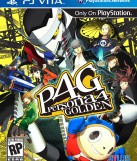It has been a very long time since a game has sucked me in for over fifty hours and yet, I still look forward to playing it some more. It is probably even stranger when it is a remake of a game that I played to that same duration a couple years ago and loved to bits. Persona 4 Golden (2012, PlayStation Vita) – P4G – takes the original Persona 4 (2008, PlayStation 2) and, rather than being just a lazy port, revamps it significantly to make it the definitive P4 experience.
I suppose I’m writing this more for those familiar with the franchise, but how would I try to describe the Persona games to beginners? Well, for one, when most players refer to these titles, they are often speaking of either Persona 3 or Persona 4. The previous titles before 3 and 4 are very different and honestly not as popular and well-received as the most recent entries. Now then, Persona takes the four-member party, dungeon-crawling, elemental rock-paper-scissors kind of Japanese RPG and turns it on its head by supporting it with a very deep, engaging, social narrative. When interpersonal bonds between characters provide tangible power, you know you’re onto a special game.
Persona 4 (2008) tells the story of a player-named protagonist, who comes from the city, yet is spending the next year in the rural town of Inaba. Rumors of the “Midnight Channel” quickly circulate throughout the town and a string of deaths lead to a mysterious serial murder case. The protagonist and his friends find out they have the ability to enter a world inside the TV, where murder victims are kidnapped and placed in to die. It’s up the protagonist to solve the mystery while still attending school and building friendships, in order to discover the truth behind the Midnight Channel.
This weekend, I plan on discussing this game on “Wut R U Playn?” – however, if I rambled on or wrote everything I liked about the game, it would take FAR too much podcast time. From the character development, to the “slice of life” gameplay, to the philosophical weight of the plot, pages could be filled with my thoughts. So instead, I thought I would write about why Persona fans need to play this “Golden” iteration, even if that means getting a PlayStation Vita. I bought my Vita specifically for this game and I couldn’t be happier with the decision, after pouring in over 80 hours with a completed New Game Plus run. I just wanted to get my thoughts out there informally and to document my experience with the game, without forgetting anything on the podcast. Perhaps this will pique the interest of the player looking from the outside of the franchise fandom, as well.
CHANGES IN PERSONA 4 GOLDEN
Wireless Features
The portable nature of the game itself is splendid, as you aren’t confined to the console, like you were with the game’s previous iteration. Whether you’re playing it in front of the TV, lying in bed, or out on the go, it just feels great to have Persona 4 redefined on that gorgeous OLED screen which the Vita boasts. While the Vita itself feels very good in the player’s hands, it is its wireless features that the game takes advantage of, which takes P4G to a whole other level. These features include S.O.S. and Vox Populi. S.O.S. may be used by players having difficulty in a dungeon, in order to call out for assistance from other online players. While I never needed to use this, I can only imagine how it might help out in a pinch, for those playing on harder difficulties. The other, Vox Populi, aka “Voice of the People,” allows the player to see a pop-up of a collection of thoughts from other players. In this case, these thoughts are gathered by the game and include what other real players did on that in-game date. This is very helpful for those playing without a guide and need a refresher of what social options are available for that day – for example, is Yukiko available to hang out today? While these online features are able to be toggled on and off in the settings menu, consistently having them on understandably requires a sufficient amount of battery use.
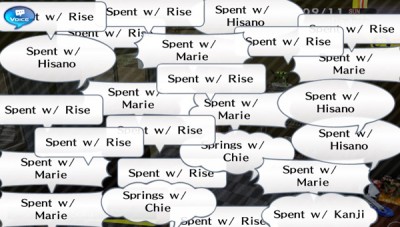
Which one will you choose?
Difficulty Settings
Persona 4 Golden offers two new difficulty settings, for a total of five. While the original had Beginner, Normal, and Expert modes, the former and latter have turned into Easy and Hard, respectively. Additionally, the Vita game offers a Very Easy and Very Hard setting – easier than the original Beginner and more difficult than the original Expert. However, these settings only affect the dungeon-crawling battle difficulty. I have never been fond of the difficulty in these games, especially when the player is only allowed to save at a specific point in the TV world. This means that a random death – especially with the chance of one-hit kill light and dark moves – can undo a lot of level grinding work. I played on Very Easy for both my playthroughs, achieved the trophies without any consequence, and enjoyed the same narrative without punishment. Not to mention, on the New Game Plus run, you get to customize the difficulty down to experience/money earned, damage dealt/received, and more. In my opinion, there is no shame in playing this game on Very Easy, especially when certain parts are guide/GameFAQs recommended.
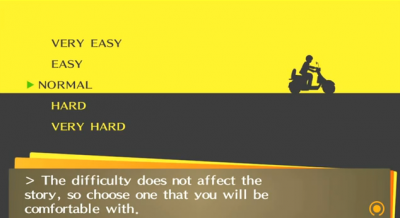
And the story is where it’s at, after all!
Events and Presentation
The game provides new events for the player to experience, which were not available in the first game. Some of these are not needed, like a Halloween celebration at Junes, while some of these can prove to be story-critical, like a skiing trip in February. Most of these come off as either fanservice or rewarding to those with knowledge of the franchise, which is accented by brand new animated cutscenes. It’s impossible to deny the fanservice, such as the Investigation Team’s girls covered with steam in the hot springs. At the same time, fans of the recent anime may appreciate a song reference made when the team decides to play as part of a musical act at Junes. Speaking of the anime, it was interesting to note how characters interacted differently with each other compared to the original game, while borrowing heavy influence from the anime portrayals. One of the girls naturally gravitates towards the protagonist more, while there is notable sexual tension between two of the team members on several occasions. Overall, the entire voice cast returns, except for Erin Fitzgerald now plays Chie and Sam Riegel plays Teddie. It takes some adjustment to get used to, if you are familiar with the original performances, but Erin and Sam fill in wonderfully and bring welcome elements to the characters. This may be an instance of “your mileage may vary” though, depending on the player’s attachment to the original actors. I was ultimately pleasantly surprised.
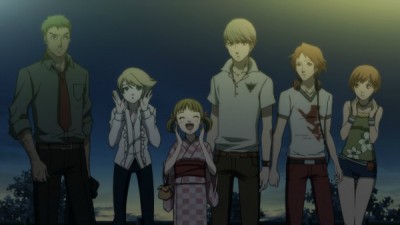
There’s even a fireworks sequence!
Social Links and Fusion
When Persona 3 received new game iterations, new social links were added, and the same is true with Persona 4. These additions in Persona 4 Golden involve the Aeon and Jester social links and it is quite intriguing to learn who you will be making bonds with. These characters are best left as a surprise, but interacting with them is important to the story for a variety of reasons, one of which includes unlocking a delightful extended epilogue. Since new social links are available, new personas are able to be fused for these Aeon and Jester arcana. Fusion is even made easier by showing players what fusion options are possible, given the persona that are currently on-hand. This player-friendliness even carries over into the transferal of moves, as players can choose which skills from a pool of available options will carry over into the final result. Ultimately, the biggest surprise for new personas involves a third-tier persona for your party members. As Persona 4 players may know, a party member’s default persona evolves after their respective social link reaches the maximum level. However, meeting with these Level 10 party members during special events in January will trigger another evolution and learned skill. This not only reflects better stat boosts, but further character development and resolution, which is always a plus.
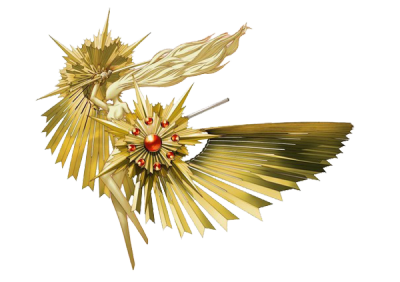
An example of a third-tier persona, looking awesome…
Battles
Battles in Persona 4 Golden have received a few new perks as well. Players can unlock a variety of outfits for party members to wear in dungeons, from Persona 3’s Gekkoukan high school outfits, to maid dresses, to sexy Santa and goofy reindeer get-ups and more. The party’s support character also has a chance to provide a damage boost during all-out attacks, among other helpful party benefits, while team members outside of the current party can occasionally follow up with critical “Cavalry Attacks.” Players can spend time with party members outside of school to learn new moves or remember old ones. Furthermore, the variety of learned skills grows even further, as reaching even social link levels with party members triggers new learned moves for that team member. On the soundtrack front, “Reach Out to the Truth” returns when a Player Advantage is triggered, but the alternate “Time to Make History” battle theme is great and will surely get stuck in your head. Overall, the basic gameplay is still the same, but the Vita game gives you more options to customize your own, personal experience with this part of the game.
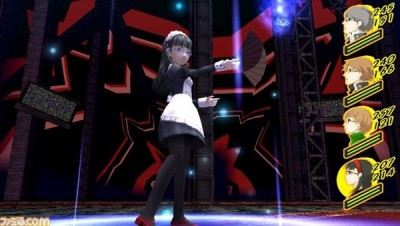
Yukiko pulls off the maid look rather nicely!
Exploration
The protagonist was relatively tied down as far as where he could travel to in the original Persona 4 game. Now, in Golden, big strides have been made in this regard. The player can now explore Inaba at night, which can involve going to work, building points for social links in a variety of ways, hunting down items for sidequests, and more. Motorcycles play a big role in the game as well, as they allow the player to travel freely to familiar locations Okina City and Shichiri Beach. This expands what the player can do after school, from drinking coffee to acquire purchasable Skill Cards, to catching a movie and leveling up a party member. The options around town don’t stop there, as the player can maintain a vegetable garden outside the Dojima residence and catch bugs at the shrine. These two felt very tacked on to me, though, especially when the latter is required to complete a quest-driven social link.
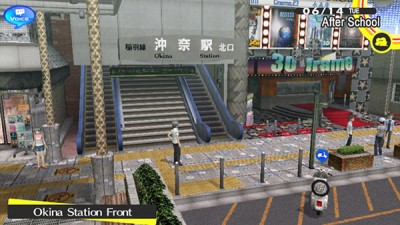
Okina City, now accessible via scooter!
TV Theming and Trophies
The theme of the television is prevalent throughout Persona 4, with the TV World, Midnight Channel, and more. Yet, Golden goes about emphasizing this even further. Players can fast forward scenes at any point by pressing the Start button twice, which plays the game in a fast-forward VCR style. Players are still able to make prompted responses, so this is ideal for cutting down time in New Game Plus after the player has already experienced Golden’s narrative. The TV theme continues with a new overlay feature that provides entertainment in addition to the main game. Players can access “channels” that update with new content over the course of the game. These channels vary from replays of in-game scenes, information about other Persona games, footage of Japanese Persona music concerts, and more. However, the channel that stands out the most is the “Miracle Quiz,” a separately produced and voiced series of trivia minigames. This proves to be quite the challenge, as the questions about Inaba and the TV world strike a good difficulty balance. Furthermore, players are encouraged to clear the Miracle Quiz with the reward of a trophy. The PlayStation Network trophies for the game are relatively well chosen and really make a difference to provide the extra completion motivation. I’ve found myself only a few shy from acquiring a Platinum trophy, with only a few complaints about trophy choice or difficulty. For example, the task of reading all of the game’s books only results in a bronze trophy, which veteran P4 players know to be a very challenging task, amongst everything else the game offers. Overall, most of the TV overlay mode was a pleasant, albeit not critical distraction, yet the addition of trophies was a wonderful gesture for this title.
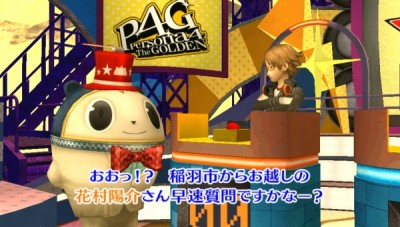
Is it any surprise that Teddie’s behind the Miracle Quiz?
Gripes
What changes would I make with Persona 4 Golden? There are very few, to be honest. This was my favorite game of 2012 and the improvements that were made to the original Persona 4 go above and beyond any simple port. My first thought regarding change is my curiosity what the game would have been like with a female protagonist. This was the big addition that Persona 3 Portable (2009, PSP) made and it involved changing social links around to create an entirely different experience. However, this suited Persona 3 better, as an analysis really makes you realize how female-centric the protagonists companions are. If this kind of drastic protagonist change was made in Persona 4, I am simply not so sure it would have been pulled off as effectively as it was in Persona 3. It would have also been nice to have Japanese voices be an option, even though the English cast does a wonderful job. After watching the anime, it would have been nice to have that as a supplemental experience during one of my playthroughs. However, that would involve a lot of space on the game cartridge and I’m not sure that sacrificing something like the TV overlay mode would free up enough space. Regardless, the game is a must-own for PlayStation Vita. As I move on to other games that I have to play, including my 2013 Gaming Resolutions, my experiences with Persona 4 Golden will continue to be very memorable.

